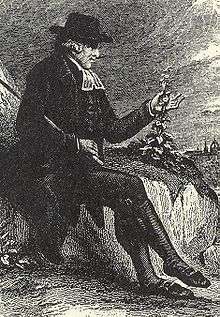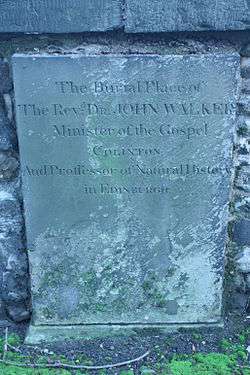John Walker (natural historian)
| Professor John Walker DD MD FRSE | |
|---|---|
 Rev Dr John Walker, Edinburgh's Professor of Natural History | |
| Born |
1731 Canongate, Edinburgh |
| Died | 31 December 1803 |
| Education | Canongate Grammar School |
| Alma mater | Edinburgh University (DD; MD) |
| Occupation | Professor of natural history, University of Edinburgh; moderator of the General Assembly of the Church of Scotland |
| Notable work |
Schediasma Fossilium (1781) Delineato Fossilium (1782) Classes Fossilium: Sive Characteres Naturales et Chymici Classium et Ordinum in Systemate Minerali (1787) Institutes of Natural History (1792) An economical history of the Hebrides and Highlands of Scotland (1808) Essays on Natural History and Rural Economy (1812) |
| Spouse(s) | Jane Wallace Wauchope (m. 1789; d. 1827) |
| Notes | |

Very Rev Prof John Walker DD MD FRSE (1731–1803) was a Scottish minister and natural historian. He was Regius Professor of Natural history at the University of Edinburgh from 1779 to 1803. He was joint founder of the Royal Society of Edinburgh in 1783 and Moderator of the General Assembly of the Church of Scotland in 1790.
Overview
Walker was a protégé of the chemist William Cullen and a colleague of Dugald Stewart, Joseph Black and several other Edinburgh professors who shaped the intellectual milieu of the Scottish Enlightenment. During his long career, he became a distinguished botanist, chemist, geologist, hydrologist, meteorologist, mineralogist, zoologist and economic historian, as well as being a minister in the Church of Scotland.
Walker was one of the main scientific consultants of his day, serving as an agricultural, industrial or mining advisor to many influential Scottish landowners, including the judge advocate Lord Kames, George III's prime minister Lord Bute, and Lord Hopetoun. Many of his students went on to become leading scientists in nineteenth century Scotland, England, Ireland, and America. He was a pioneer in introducing agricultural topics into a university curriculum.[1]
As a member of the Philosophical Society of Edinburgh when it received its royal charter, Walker automatically became a Fellow of the Royal Society of Edinburgh in 1783, going on to serve as Secretary of the Society's Physical section (1789–96). He was elected as Moderator of the General Assembly of the Church of Scotland in 1790.
Early life
Born in Canongate, Edinburgh to a schoolmaster father, he matriculated at the University of Edinburgh in 1746. Like many aspiring men in Scotland at this time, he took a divinity degree in 1749. He was soon ordained into the Church of Scotland (Presbyterian) and spent the next thirty years as a parish minister. However, his duties did not stop him from pursuing scientific subjects in his spare time. While at university he had taken natural philosophy courses and had collected natural history specimens in and around the Lothians. During the 1750s he continued to pursue scientific subjects by studying chemistry under Prof. William Cullen and by joining Edinburgh's Philosophical Society. He distinguished himself not only by winning awards from the society but also by publishing an article in the 1757 edition of the Philosophical Transactions of the Royal Society of London. Under Cullen's patronage, Walker further distinguished himself as a chemist and a mineralogist and this led him to function as a scientific advisor for Lord Bute, Lord Hopetoun, Lord Cathcart, and Judge Advocate Lord Kames.
Becoming a naturalist
During the 1760s he used his aristocratic connections to tour mines throughout the Lowlands and to assemble his own sizeable mineralogical collection. By the mid-1760s, Walker was known as one of Scotland's leading lay naturalists. This motivated the Church of Scotland and the Board of Annexed Estates to send him on exploratory tours of the Highland and Hebrides in 1764 and 1771. These tours allowed him to make religious and ethnographic observations for the church and to take scientifically oriented notes on northern Scotland's minerals, plants, animals, and climate. In his 1764 tour, while on visit to the Island of Jura (Deer Island), Walker may have made the first detailed description of the Lyme disease. He gives a good description both of the symptoms (with "exquisite pain [in] the interior parts of the limbs") and of the tick vector itself, which he describes as a "worm" with a body which is "of a reddish colour and of a compressed shape with a row of feet on each side" that "penetrates the skin".[2]
During the 1770s Walker published articles in the Scots Magazine and the Philosophical Transactions. By the mid part of the decade, it became clear that Robert Ramsey, the University of Edinburgh's ailing Professor of Natural History, would soon need to be replaced. After securing the support of William Cullen, Lord Kames and several other politically savvy intellectuals, Walker competed against William Smellie, a well-respected natural historian and influential publisher, for the post. After much wrangling, Walker won the contest and was appointed in 1779. He held the position until his death in 1803.
Later life
Walker's natural history lectures spanned the academic year and were divided into two sections. The first half of the year he gave his 'Hippocratean' lectures, that is, meteorology, hydrology and geology. The second half of the year was devoted to the three kingdoms of nature: minerals, plants, and animals. During the 1760s, he had accepted Linnaeus' binomial classification system and during his university tenure he readily applied it to botany. However, he did not agree with Linnaeus' classification of minerals and animals and therefore he developed his own unique system for both of these subjects. As shown by Matthew Daniel Eddy, Walker developed a sophisticated theory of the earth based on evidence gathered from geochemistry and human history. Throughout his entire career he kept his ties with the Kirk and in 1790 he was elected to be Moderator, its highest position. Sometime in the late 1790s he began to lose his sight and several of his lectures were taken over by Dr Robert Jameson, a physician and former student who had also studied in mainland Europe. By the time that he died in 1803, Walker had taught well over eight hundred students, some of whom would go on to have a significant impact on nineteenth century natural history. Some of these names include Rev. Prof. John Playfair, Sir James Edward Smith, Sir James Hall, Mungo Park, Robert Waring Darwin, Robert Brown, Thomas Beddoes, Thomas Charles Hope, and Samuel Latham Mitchell.
He died at his home at 1 St John Street[3] on the Canongate on New Year's Eve 1803/4.
He is buried in Canongate Kirkyard on the Royal Mile in Edinburgh, just east of the church building.
See also
References
- ↑ Waterston, Charles D; Macmillan Shearer, A (July 2006). Former Fellows of the Royal Society of Edinburgh 1783–2002: Biographical Index (PDF). II. Edinburgh: The Royal Society of Edinburgh. ISBN 978-0-902198-84-5. Archived from the original (PDF) on 4 October 2006. Retrieved 8 February 2011.
- ↑ Summerton N (1995). "Lyme disease in the eighteenth century". BMJ. 311 (7018): 1478. doi:10.1136/bmj.311.7018.1478.
- ↑ Edinburgh and Leith Post Office Directory 1800-1801
Further reading
- Eddy, Matthew Daniel, 'Geology, Mineralogy and Time in John Walker's University of Edinburgh Natural History Lectures', History of Science, 39 (2001), 95–119.
- Eddy, Matthew Daniel, 'The University of Edinburgh Natural History Class Lists', Archives of Natural History, 30 (2003), 97–117.
- Matthew Daniel Eddy, The Language of Mineralogy: John Walker, Chemistry and the Edinburgh Medical School, Aldershot: Ashgate Publishing Ltd, 2008, ISBN 978-0-7546-6332-4
- Withers, C. W. J. 'The Rev. Dr John Walker and the practice of natural history in late eighteenth century Scotland', Archives of Natural History, 18 (1991), 201–220.
- Withers, C. W. J. 'A neglected Scottish agriculturalist: The geological lectures and agricultural writings of the Rev. Dr. John Walker (1731–1803)', Agricultural History Review, 1985, 33: 132–146.
External links

| Church of Scotland titles | ||
|---|---|---|
| Preceded by George Hill |
Moderator of the General Assembly of the Church of Scotland 1790 |
Succeeded by Robert Small |